Trends in Engineering Enrolment and Degrees Awarded 2016-2020
Message from the Chief Executive Officer

Engineers Canada is pleased to publish the 2021 edition of Canadian Engineers for Tomorrow, highlighting trends related to enrolment and degrees awarded in post-secondary engineering education in Canada. This document comprises information on all academic terms from the calendar years 2016 through 2020.
Canadian post-secondary institutions continue to report a strong growth in undergraduate degrees awarded, presenting 22.0 per cent more engineering degrees in 2020 than in 2016. It is once again positive to see that most engineering disciplines awarded more degrees in 2020 than in 2016, and that many engineering disciplines have experienced a growth in undergraduate enrolment numbers in the same period.
We are excited to report that the proportion of self-identified female students enrolled in undergraduate and postgraduate programs, as well as the proportion receiving undergraduate degrees, has reached an all-time high. As of 2020, self-identified females comprised 24.2 per cent of undergraduate students, 27.4 per cent of postgraduate students, and 22.8 per cent of undergraduate engineering degrees awarded. As the profession moves toward Engineers Canada’s 30 by 30 goal – where 30 per cent of newly licensed engineers are women by 2030 – this increasing representation at the undergraduate level is an important indicator of progress.
Meanwhile, Canadian engineering programs remain a popular choice for international students. In 2020, the number of international undergraduate students reached 16,188, or 17.9 per cent of total undergraduate engineering enrolment.
For the sixth consecutive year, Engineers Canada collected data regarding Indigenous students’ enrolment and degrees awarded. Indigenous people are still greatly underrepresented in engineering education, accounting for only 0.6 per cent of reported undergraduate students. This is around eight times lower than the 4.9 per cent of people in Canada who identify as Indigenous (Statistics Canada, 2017).
Engineers Canada will continue to track this information in the coming years to identify trends and to further encourage enrolment and achievement by post-secondary engineering programs that reflect Canada’s diversity.
Gerard McDonald, MBA, P.Eng., ICD.D
Chief Executive Officer
Acknowledgements
In preparing this report, Engineers Canada gratefully acknowledges the contribution of data and information from the deans and associate deans of the engineering and applied science faculties at Canadian higher education institutions.
Report By: Adam Rodrigues
Introduction
Canadian Engineers for Tomorrow is an annual examination of Canada's undergraduate and postgraduate engineering programs. It evaluates trends in part- and full-time student enrolment and degrees awarded over a five-year period. In 2021, 43 higher education institutions provided information on their enrolment, programs, and degrees awarded.
The results highlight enrolment trends by discipline and institution, as well as the number of undergraduate and postgraduate degrees awarded each year. These results reveal trends specific to discipline, education level, gender, and international students’ participation in Canadian engineering education as well as the number of engineering graduates available to enter the labour market. Enrolment trends at the undergraduate, Master’s, and doctoral levels are compared, along with self-identified male and female students studying and graduating from engineering programs. For the sixth consecutive year, data regarding Indigenous peoples’ enrolment and graduation from engineering programs is presented in this report. Engineers Canada plans to continue collecting this data in coming years to be able to identify emerging trends.
Data is provided by higher education institutions (HEIs) to Engineers Canada and compiled for this report. Findings are then shared with stakeholders in engineering across Canada and the public in the form of this report. Engineers Canada greatly appreciates the contribution of the higher education institutions to this work.
Notes to the reader
-
When comparing data between years, only those higher education institutions who consistently responded to the survey year-after-year are included in the comparison. If an institution did not provide data in one or more of those years, they were not included in the comparison. This is done to ensure that the comparisons are fair and as accurate as possible. Small inaccuracies in the reported data, as well as changes in programming, will affect the percentages presented throughout the report.
-
Four program types were re-classified from engineering physics to the "other" category, affecting a total of 6 engineering programs. Though it may appear that there is an increase in the percentage of enrolment and degrees awarded, this is only a consequence of the reclassification and does not reflect any actual increases in those programs that are part of the other category.
-
Sex identifiers have been limited to ‘male’, ‘female’, ‘non-binary’, and ‘prefer not to specify’". We use ‘female-identified’ to describe individuals who self-identified as female and ‘male-identifying’ to describe individuals who self-identified as male, to limit the conflation of sex and gender and acknowledge the gender diversity that exists within these sex identities.
Undergraduate students
Total undergraduate student enrolment
Undergraduate student enrolment in accredited engineering programs totalled 90,311 in 2020. This is an increase of 8.0 per cent from 2016 and a 2.0 per cent increase from 2019.
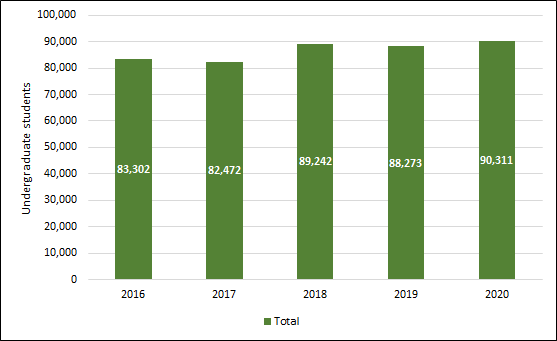
Total undergraduate student enrolment by discipline
The undergraduate engineering disciplines with the highest enrolment in 2020 were mechanical engineering, civil engineering, and electrical engineering. These represent 22.0 per cent, 13.3 per cent, and 11.8 per cent of total undergraduate enrolment, respectively. Conversely, the fields that accounted for the smallest proportion of undergraduate enrolment were materials or metallurgical engineering (1.0 per cent), mining or mineral engineering (0.9 per cent), and geological engineering (0.6 per cent).
Computer engineering (10.9 per cent), biosystems engineering (10.2 per cent), and software engineering (7.5 per cent) demonstrated the highest growth since the previous year. Similarly, the disciplines that experienced the largest cumulative growth from 2016 were biosystems engineering (66.2 per cent), software engineering (59.0 per cent), and computer engineering (49.7 per cent). Conversely, mining or mineral engineering (-12.4 per cent), geological engineering (-7.8 per cent), and chemical engineering (-2.6 per cent) had the largest decline from the previous year.
Seven disciplines experienced a decline in enrolment since 2016: engineering physics (-57.7 per cent), mining or mineral engineering (-33.5 per cent), geological engineering (-25.4 per cent), electrical engineering (-6.5 per cent), chemical engineering (-6.3 per cent), and civil engineering (-3.3 per cent). Once again, these comparisons were made between institutions that consecutively replied to the enrolment and degrees awarded survey since 2016.
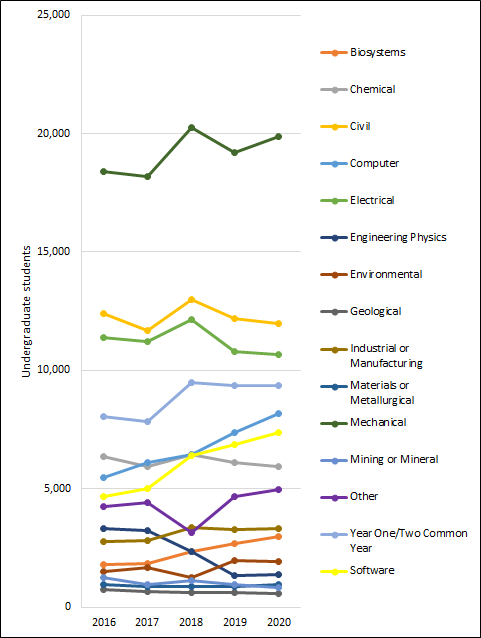
Total undergraduate student enrolment by province
The highest proportion of undergraduate enrolment continues to be in Ontario and Quebec. In 2020, these provinces accounted for 45.5 per cent and 24.2 per cent of total enrolment, respectively. Furthermore, New Brunswick (13.8 per cent) and Prince Edward Island (11.7 per cent) underwent the largest percentage increase in enrolment from the previous year.
The highest cumulative enrolment growth from 2016 occurred in Alberta (21.1 per cent) and British Columbia (13.3 per cent).
Nova Scotia (-4.5 per cent), Manitoba (-1.4 per cent), and Newfoundland and Labrador (-0.4 per cent) were the only provinces to experience a decrease from the previous year. Nova Scotia (-13.1 per cent), and Saskatchewan (-1.6 per cent) were the only provinces to experience a decrease in enrolment since 2016. Once again, these comparisons were made between institutions that consecutively replied to the enrolment and degrees awarded survey since 2016.
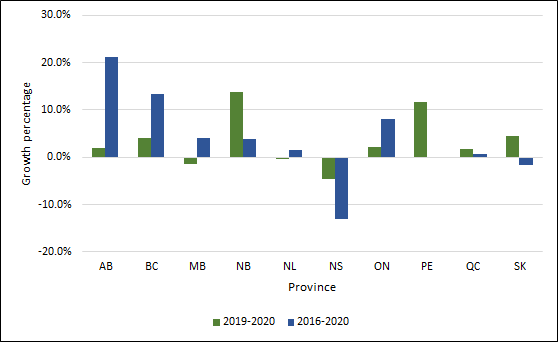
(2016-2020, 2019-2020, full-time equivalent)
Total undergraduate degrees awarded
The number of undergraduate degrees awarded totalled 18,185 in 2020, which is an increase of 1.8 per cent from the previous year. This is a noteworthy increase when compared to the average annual increase of 5.1 per cent for the period of 2016 to 2020. Cumulatively, the number of degrees awarded across Canada has increased 22.0 per cent from 2016. Once again, these comparisons were made between institutions that consecutively replied to the enrolment and degrees awarded survey since 2016.

Chart 1.5 shows that Prince Edward Island, Ontario, and Manitoba had the highest increases in undergraduate degrees awarded from 2019, growing 31.8 per cent, 20.0 per cent, and 12.7 per cent, respectively. Similarly, Nova Scotia, British Columbia, and Ontario experienced the highest increases in undergraduate degrees awarded from 2016, with growth of 34.4 per cent, 33.7 per cent, and 26.6 per cent, respectively.
Quebec (-22.1 per cent), and New Brunswick (-14.3 per cent) experienced decreases in undergraduate degrees awarded from the previous year. No provinces experienced a decrease in undergraduate degrees awarded from 2016. Once again, these comparisons were made between institutions that consecutively replied to the enrolment and degrees awarded survey since 2016.
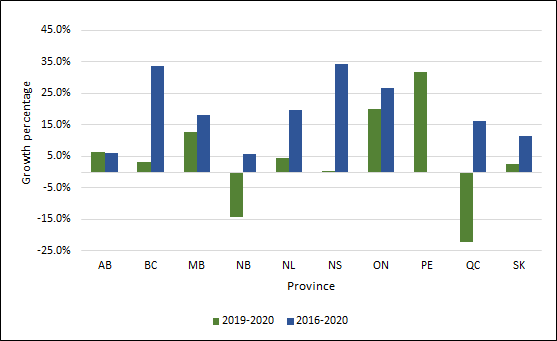
Mechanical engineering, civil engineering, and electrical engineering awarded the greatest number of degrees in 2020, representing 25.4 per cent, 16.2 per cent, and 14.2 per cent of the total, respectively. Furthermore, computer engineering exhibited the largest growth in degrees awarded from 2019 (22.3 per cent) and software engineering exhibited the largest growth in degrees awarded from 2016 (129.5 per cent).
Engineering physics (-54.8 per cent), mining or mineral engineering (-47.8 per cent), geological engineering (-11.8 per cent), and materials or metallurgical engineering (-2.4 per cent) were the only disciplines to experience decreases since 2016 in the number of undergraduate degrees awarded. Mining or mineral engineering (-34.8 per cent), engineering physics (-21.3 per cent), chemical engineering (-12.1 per cent), biosystems engineering (-11.1 per cent), and civil engineering (-4.1 per cent) have seen decreases since 2019.
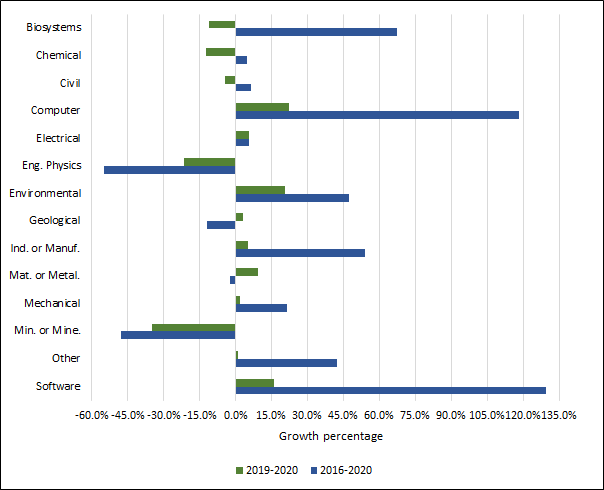
Postgraduate students
Total postgraduate student enrolment
Postgraduate student enrolment totalled 29,647 in 2020. When comparing institutions that consecutively replied to this survey since 2016, graduate student enrolment increased by 1.4 per cent from 2019 and 31.1 per cent from 2016, averaging a 7.1 per cent annual growth rate.
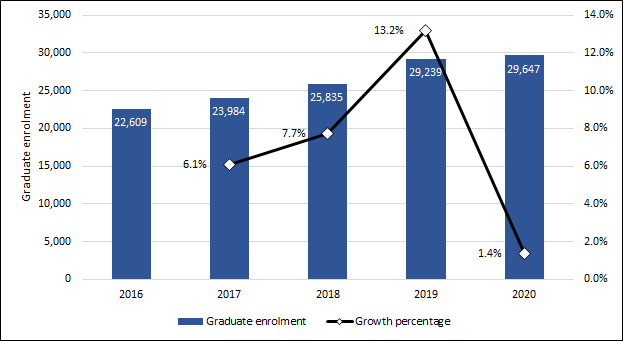
The province that experienced the highest growth in postgraduate enrolment over the previous year was New Brunswick (84.8 per cent). The province that displayed the highest cumulative growth since 2016 was Quebec (7.1 per cent). The provinces to experience a decrease from 2019 were Prince Edward Island (-10.0 per cent), Alberta (-6.9 per cent), Saskatchewan (-6.4 per cent), Nova Scotia (-5.0 per cent), and British Columbia (-1.7 per cent). No province reported an aggregate decrease in postgraduate student enrolment from 2016. Once again, these comparisons were made between institutions that consistently reported to the enrolment and degrees awarded survey since 2016.
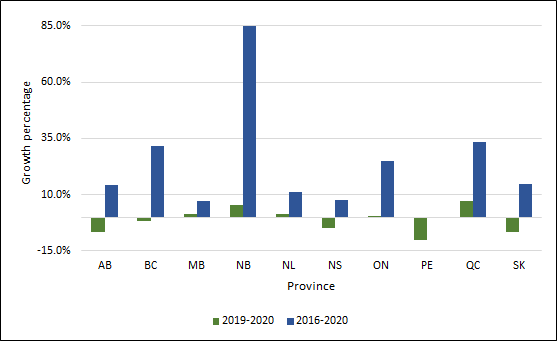
Total postgraduate degrees awarded
A total of 9,529 Master's and 1,578 doctoral of engineering degrees were awarded in 2020, for a combined total of 11,107 postgraduate degrees. This corresponds to a growth of 7.1 per cent in Master’s degrees awarded and a decrease of -6.4 per cent in doctoral degrees awarded from 2019. There has been a cumulative growth of 46.8 per cent in Master’s degrees awarded and 17.2 per cent in doctoral degrees awarded since 2016.
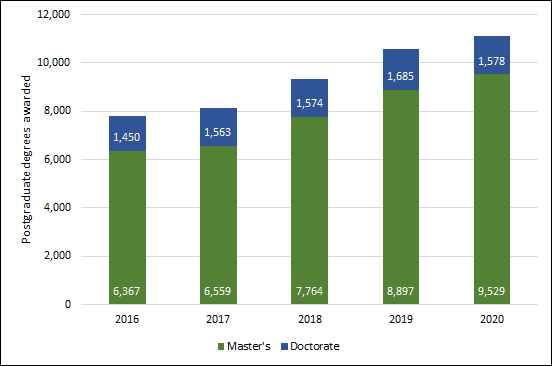
Newfoundland and Labrador had the largest growth in the number of Master’s degrees awarded in 2019 (69.7 per cent) and Alberta had the largest growth since 2016 (94.3 per cent).
Chart 1.10 indicates the average growth in Master’s degrees awarded by province for the periods of 2016 to 2020 and 2019 to 2020, while Chart 1.11 indicates the same data for doctoral degrees. Once again, these comparisons were made between institutions that consecutively replied to the enrolment and degrees awarded survey since 2016.

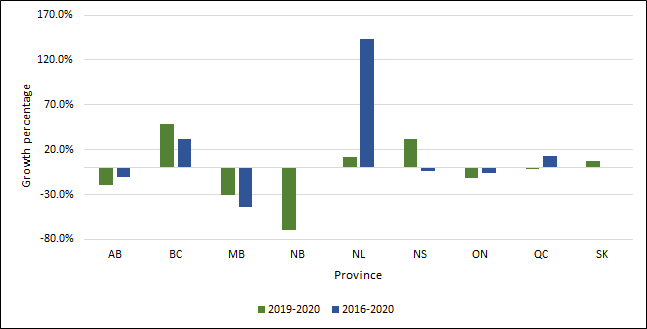
Female-identified students
Female-identified undergraduate enrolment
Female-identified undergraduate enrolment remained above 20 per cent in 2020, with a 0.8 per cent increase from 23.4 per cent in 2019 to 24.2 per cent in 2020. The total number of self-identified females enrolled in undergraduate-level engineering programs has increased by 6.0 per cent since 2019 and 25.0 per cent since 2016.
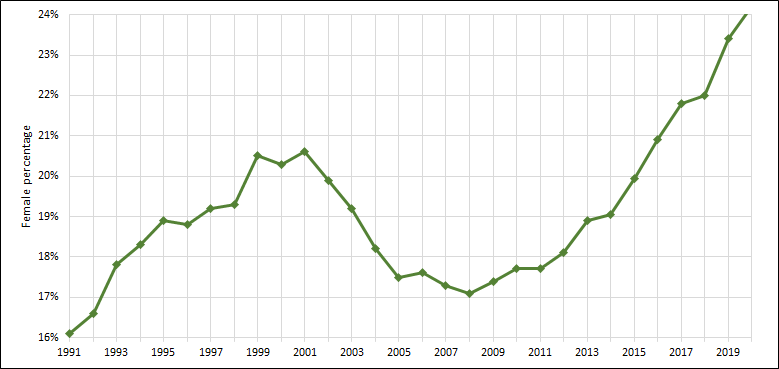
Female-identified undergraduate enrolment by discipline
The disciplines that experienced the highest proportion of female-identified undergraduate enrolment in 2020 were biosystems engineering (53.1 per cent), chemical engineering (42.2 per cent), and geological engineering (37.4 per cent).
The disciplines with the lowest percentages of female-identified undergraduate enrolment were mechanical engineering (16.2 per cent), mining or mineral engineering (16.4 per cent), software engineering (17.0 per cent), and computer engineering (17.2 per cent). While these four disciplines account for 40.2 per cent of the total number of undergraduate students, they only account for 28.0 per cent of the total number of female-identified undergraduate students.
Furthermore, the disciplines that experienced the highest growth in the proportion of female-identified students from 2019 were software engineering, engineering physics, and biosystems engineering which rose 27.9 per cent, 17.1 per cent, and 16.7 respectively.
Similarly, the disciplines that experienced the highest growth in the proportion of female-identified students from 2016 were software engineering, biosystems engineering, and computer engineering, which rose 121.7 per cent, 94.3 per cent and 87.8 per cent, respectively.
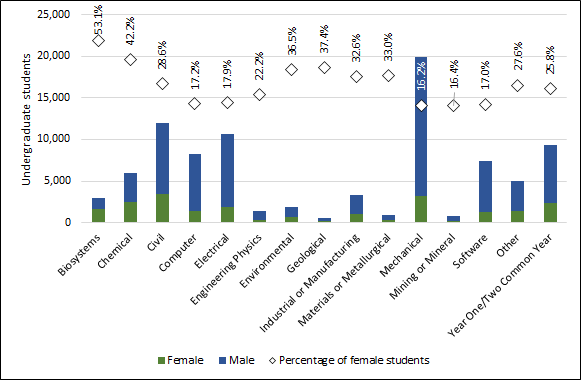
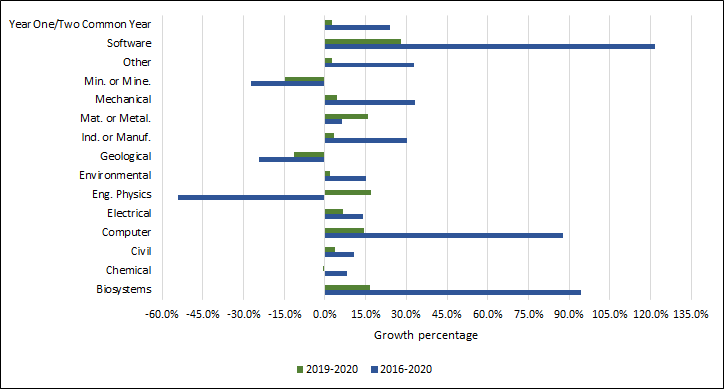
Female-identified undergraduate enrolment by province
Newfoundland and Labrador had the highest percentage of female-identified undergraduate students (27.2 per cent), while Prince Edward Island had the lowest (16.6 per cent). As is demonstrated in Chart 2.5, eight provinces experienced increases in female-identified undergraduate enrolment since 2019, while eight provinces experienced increases since 2016. Once again, these comparisons were made between institutions that consecutively replied to the enrolment and degrees awarded survey since 2016.
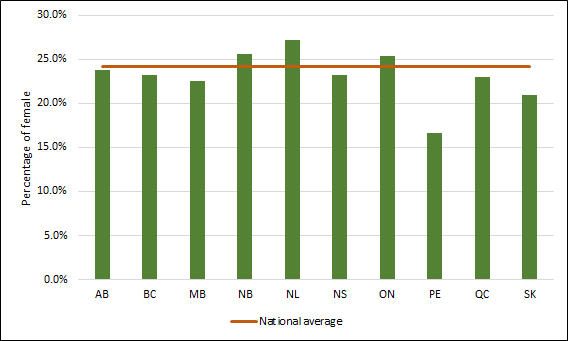
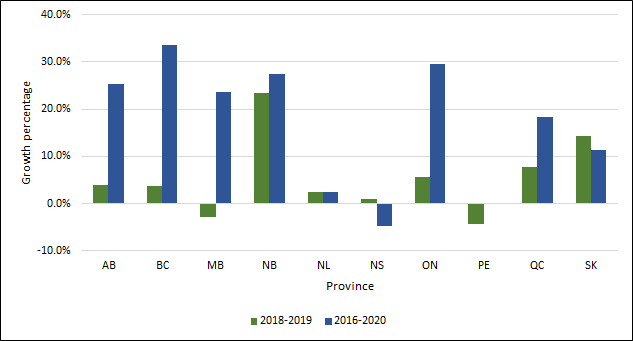
Undergraduate degrees awarded to female-identified students
Of the 18,185 engineering degrees awarded in 2020, 4,148 were awarded to female-identified students, accounting for 22.8 per cent of the graduates. When comparing engineering programs that consecutively replied to this survey, increases of 5.1 per cent from 2019 and 43.9 per cent from 2016 were observed.
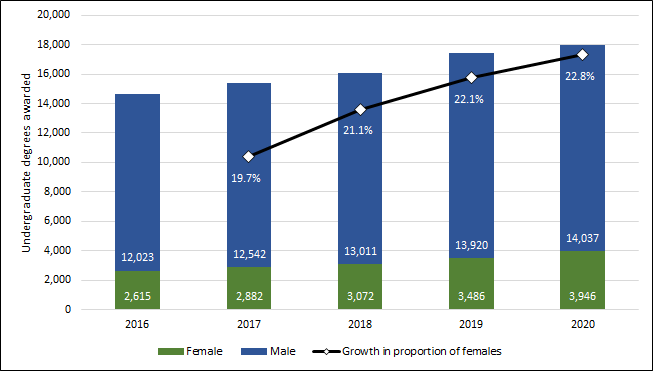
The provinces with the highest proportion of undergraduate degrees awarded to female-identified students are Newfoundland and Labrador (27.5 per cent), followed by Nova Scotia (24.3 per cent), and Ontario (23.5 per cent). Additionally, Saskatchewan had the greatest increase in the proportion of undergraduate degrees awarded to female-identified graduates when compared to 2019, with a growth of 4.0 percentage points overall.
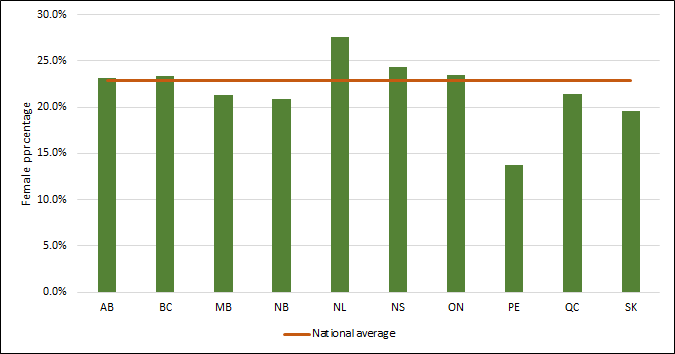
The disciplines that had the highest growth over the previous year in the proportion of undergraduate degrees awarded to female-identified graduates were that of software engineering (10.5 percentage points increase) and environmental engineering (7.4 percentage points increase). The categories that experienced the highest growth from 2016 were those of biosystems engineering (9.1 percentage points increase) and computer engineering (8.7 percentage point increase).
If it is assumed that the proportion of female-identified students granted degrees matches pace with the number of female-identified students enrolled, the proportion of undergraduate degrees awarded to female-identified graduates will likely experience growth in the coming years due to the increase in the proportion of female-identified undergraduate enrolment in many engineering disciplines, as illustrated in Chart 2.3. This is particularly notable for disciplines experiencing the highest growth of female-identifying students, such as software engineering, computer engineering, and biosystems engineering.
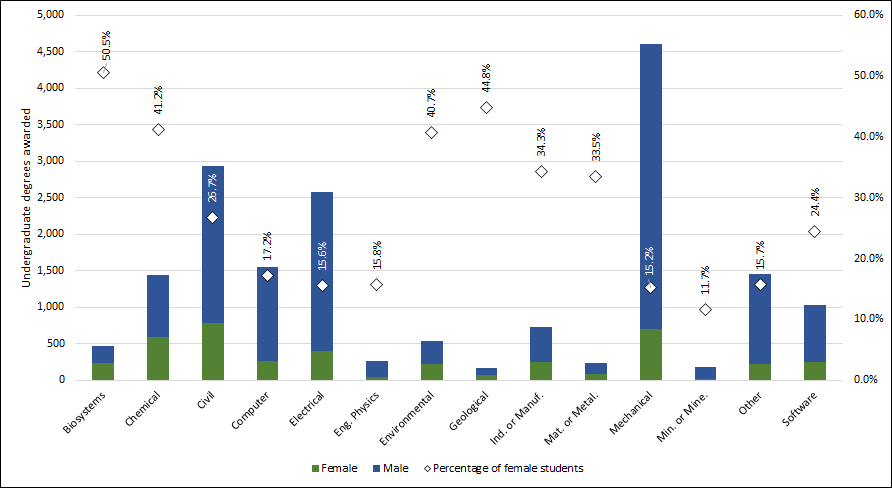
Female-identified postgraduate student enrolment
The proportion of female-identified students enrolled in postgraduate engineering programs continues to grow, reaching 27.4 per cent in 2020. When comparing institutions that consistently replied to this survey since 2016, an increase in proportion of 0.8 percentage points from 2019 and 2.6 percentage points from 2016 was observed.
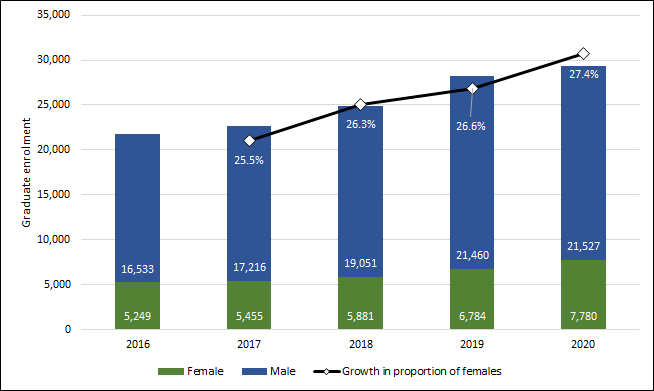
The highest proportions of female-identified postgraduate enrolment in 2020 were in Prince Edward Island, Nova Scotia, and Manitoba, with values of 33.3 per cent, 33.0 per cent, and 30.2 per cent, respectively.
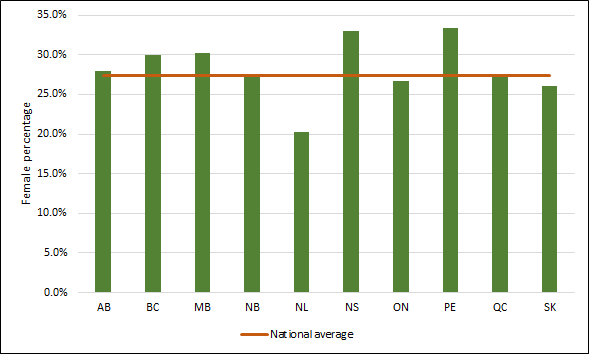
Postgraduate degrees awarded to female-identified students
The number of postgraduate degrees awarded to female-identified students in 2020 consisted of 2,430 master’s degrees and 354 doctoral degrees. When compared to 2019, this represented a 30.1 per cent increase in the number of master's degrees awarded and a -10.2 per cent decrease for doctoral degrees awarded. When comparing institutions that consistently replied to this survey since 2016, the proportion of master's degrees awarded to female-identified students has increased from 21.0 per cent in 2019 to 25.5 per cent in 2020. The proportion of doctoral degrees awarded to female-identified students went from 23.4 per cent in 2019 to 22.4 per cent in 2020.
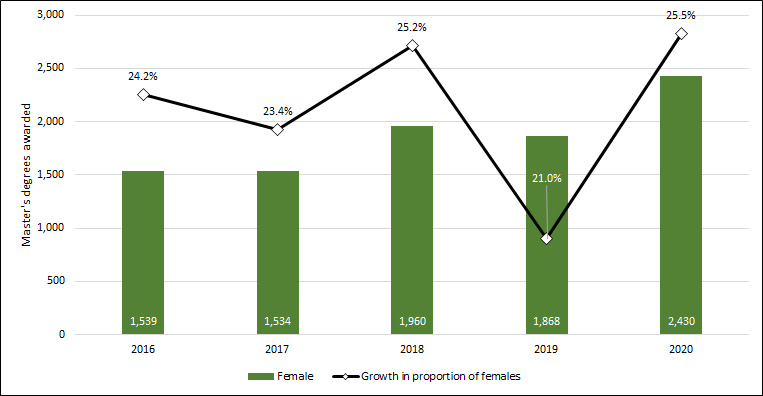
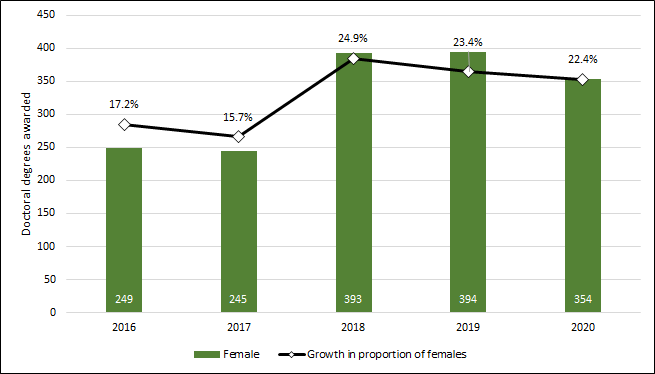
In 2020, the province with the largest proportion of master’s degrees awarded to female-identified students was Manitoba, at 38.6 per cent. Nova Scotia had the greatest percentage of female-identified students awarded doctoral degrees at 24.0 per cent. Conversely, the province with the smallest proportion of master’s and doctoral degrees awarded to female-identified students was New Brunswick, at 9.4 percent and 9.1 percent.
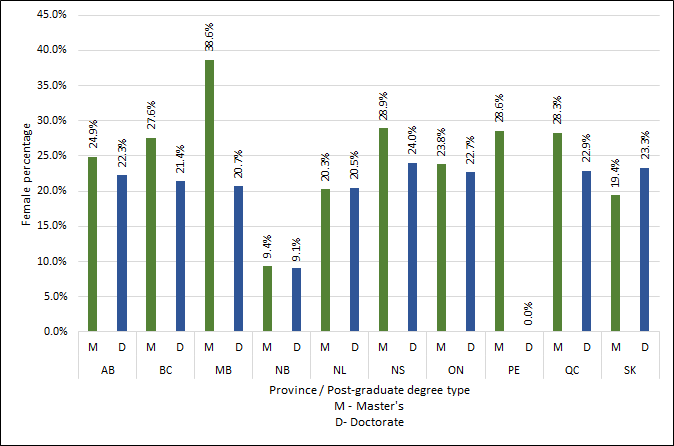
International students
International undergraduate enrolment
There were 16,188 international students enrolled in undergraduate engineering programs in 2020, accounting for 17.9 per cent of total enrolment. When comparing institutions that consecutively replied to this survey since 2016, international students represented 16.2 per cent of total undergraduate enrolment and 17.3 per cent in 2019. This means that the proportion of international students enrolled in undergraduate engineering programs has increased 10.9 per cent since 2016 and 3.6 per cent since the previous year.
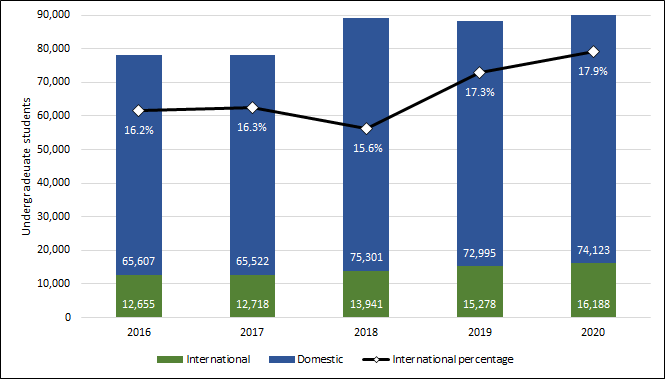
International undergraduate enrolment by discipline
In 2020 the disciplines with the highest proportion of international students enrolled were materials or metallurgical engineering (34.8 per cent) and mining or mineral engineering (24.1 per cent). Conversely, the programs with the lowest proportion of international students were geological engineering and engineering physics, at 10.7 per cent and 9.8 per cent, respectively.
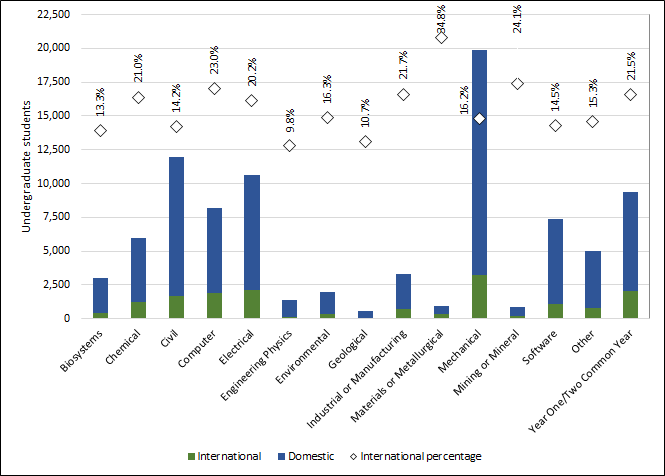
International undergraduate enrolment by province
Of the 16,188 international students enrolled in undergraduate engineering programs in Canada in 2020, 41.2 per cent (6,668 students) studied in Ontario and 24.0 per cent (3,889 students) studied in Quebec. Prince Edward Island and Nova Scotia had the highest proportion of international students enrolled at 32.4 per cent (88 students) and 32.5 per cent (639 students), respectively. The largest growth in international student enrolment over the previous year occurred in Price Edward Island (23.5 per cent) and Newfoundland and Labrador (13.7 per cent).

International undergraduate degrees awarded
In 2020, 2,737 of the 18,185 undergraduate degrees awarded were conferred on international students, representing 15.1 per cent overall. When comparing institutions that consecutively replied to this survey since 2016, the proportion of degrees awarded to international students has grown 31.2 per cent since 2016 and 1.4 percent since 2019.
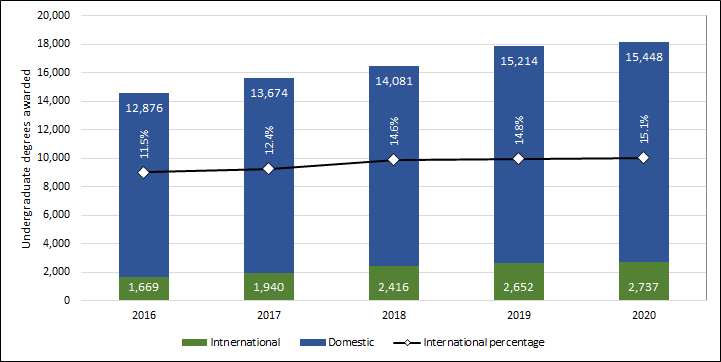
International postgraduate student enrolment
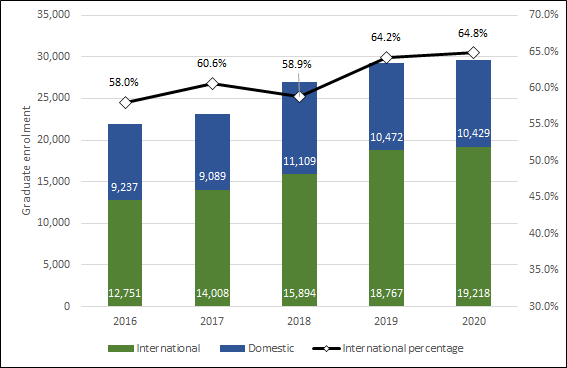
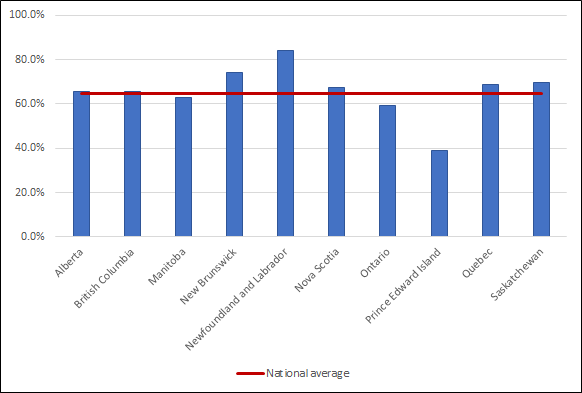
International postgraduate degrees awarded
In 2020, the number of master's degrees awarded to international students totalled 6,458 and the number of doctoral degrees totalled 872. When comparing institutions that consecutively replied to this survey, master’s degrees awarded to international students increased by 16.0 percent since 2016 and 0.2 per cent over the previous year, while doctoral degrees awarded increased by 60.6 per cent since 2016 and 1.4 per cent over the previous year.
The proportion of postgraduate degrees awarded to international students reached 67.8 per cent of all master's degrees and 55.3 per cent of all doctoral degrees in 2020. This represents growth from 2016, when the proportion of master's degrees awarded was 58.4 per cent and that of doctoral degrees awarded was 34.4 per cent.
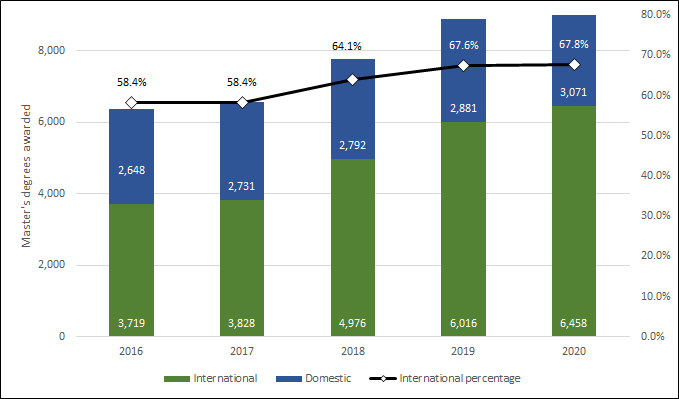
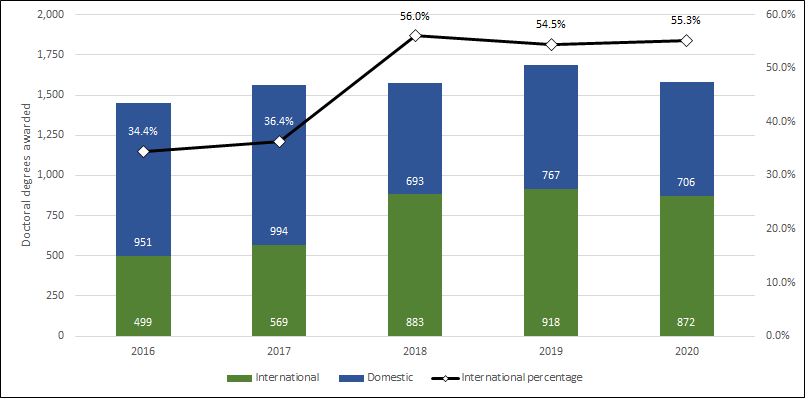
In 2020, Newfoundland and Labrador, Nova Scotia, and Quebec had the greatest proportion of master's degrees awarded to international students at 93.2 per cent, 82.6 per cent, and 72.9 per cent, respectively. Similarly, Newfoundland and Labrador, Saskatchewan, and Manitoba awarded the greatest proportion of doctoral degrees to international students at 84.6 per cent, 76.7 per cent, and 65.5 per cent, respectively.
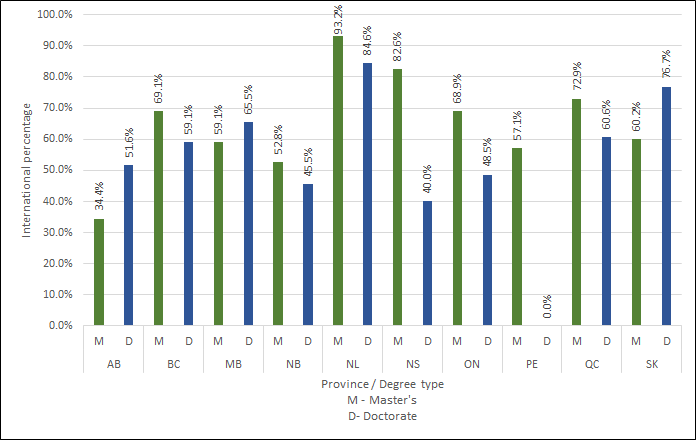
Indigenous student enrolment and degrees awarded
Of the 43 institutions that responded to the enrolment and degrees awarded survey, 21 provided information about Indigenous students. As the reported numbers are of a small magnitude, the data on Indigenous student enrolment is presented in a cumulative form to assure anonymity. While not all institutions are able to report Indigenous identity of their students, this data assists the engineering community in pursuing conversations on increasing the representation of Indigenous people in engineering. Even if a comprehensive and true representation of Indigenous student enrolment and degrees awarded is not available at this time, the data here provides an important starting point.
Of the 21 institutions who provided data, 19 institutions provided information on undergraduate Indigenous student enrolment. The institutions providing this data represent 51 per cent the total undergraduate enrolment in engineering programs in Canada. Eleven institutions, representing 28.8 per cent of total degrees awarded, provided information on undergraduate degrees awarded to Indigenous students. In addition, 11 institutions, representing 36.3 per cent of postgraduate student enrolment, provided data on Indigenous student postgraduate enrolment. Finally, eight institutions, representing 21.0 per cent of all postgraduate degrees awarded, provided data on Indigenous student postgraduate degrees awarded.
While Indigenous people make up 4.9 per cent of the population in Canada1, Indigenous students only account for 0.6 per cent of total undergraduate enrolment in engineering programs and 0.8 per cent of undergraduate degrees awarded. Postgraduate student enrolment is 0.1 per cent of total enrolment, and 0.1 per cent of postgraduate degrees were awarded to Indigenous students.
[1]Government of Canada. Aboriginal peoples in Canada: Key results from the 2016 Census. The Daily, October 25, 2017, https://www150.statcan.gc.ca/n1/daily-quotidien/171025/dq171025a-eng.htm?indid=14430-1
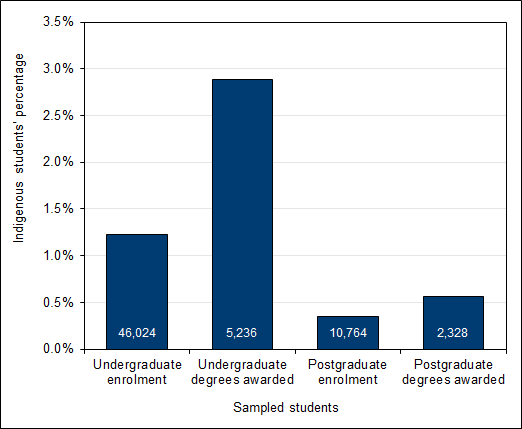
Faculty members
There was a total of 4,912 full-time equivalent engineering faculty members across Canada in 2020. When comparing institutions that consecutively replied to this survey since 2016, the number of full-time equivalent faculty members has increased by 0.6 per cent since 2019 and 14.7 per cent since 2016. The proportion of female-identified faculty increased from the previous year from 16.8 per cent to 17.3 per cent.
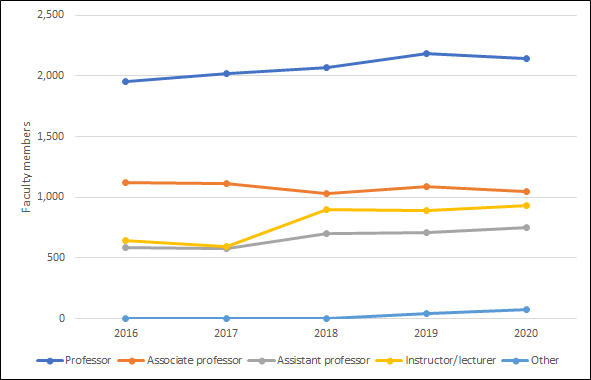
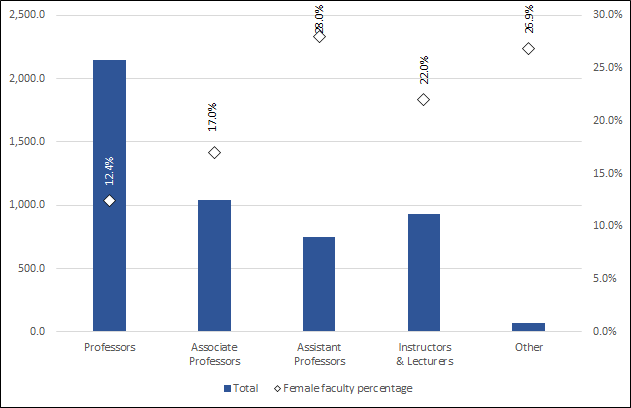
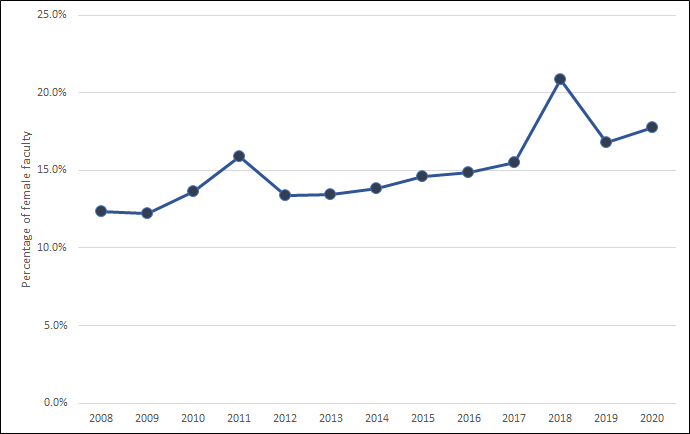
Small inaccuracies in the reported data as well as changes in programming will affect the percentage presented in Chart 5.3.
Appendix A
Data can be downloaded in Excel format.
Undergraduate Enrolment (U)
Undergraduate Degrees Awarded (UD)
Postgraduate Student Enrolment (G)
Postgraduate Degrees Awarded (GD)
Faculty Members by institution (F)
Co-op, Internship, and Professional Experience Programs (C)
